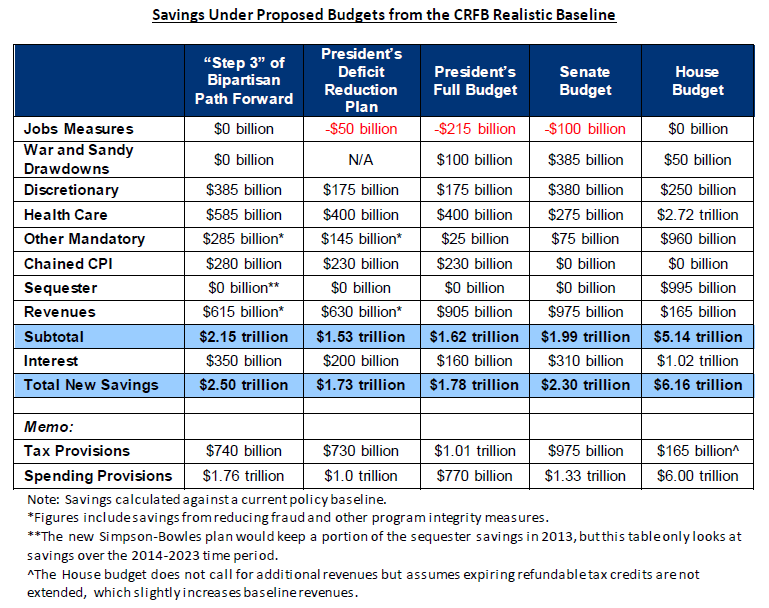Comparing the Bipartisan Path to Other Budget Proposals
Earlier today, Fiscal Commission co-chairs Erskine Bowles and Alan Simpson released a new comprehensive debt reduction plan with $2.5 trillion of savings, entitled "A Bipartisan Path Forward to Securing America's Future." The plan is intended to show lawmakers a possible way to achieve a compromise that can put debt on a sustainable, downward path. From the report:
The plan we have put forward here is not our ideal plan, it is not the perfect plan, and it is certainly not the only plan. It is an effort to show both sides that a deal is possible; a deal where neither side compromises their principles but instead relies on principled compromise.
The plan builds off of the White House and House Republican offers in the fiscal cliff negotiations, but pushes both sides to compromise further to achieve the needed additional deficit reduction. With that in mind, we can compare the Bipartisan Path with other major budget proposals to see how this plan matches up in the budget debate. The following table shows deficit reduction in the new Bipartisan Path plan relative to the CRFB Realistic baseline, compared to the Senate, House, and White House budget proposals (as well as the President's deficit reduction offer alone).

While the President's budget (and President's deficit offer) projections rely on OMB’s economic and technical assumptions, CRFB staff have roughly estimated how the President’s deficit reduction offer and full budget could stack up when incorporating CBO's economic and technical assumptions. That way, we can produce something closer to an apples-to-apples comparison of how the different proposals would impact revenues, spending, and debt as a percentage of GDP.
By finding savings across the budget, the "Bipartisan Path Forward" is able to put debt on a clear downward path, reaching 69.3 percent of GDP by 2023. Other budget would also put debt on a downward path, with the House budget taking a more aggressive approach on deficit reduction than the "Bipartisan Path Forward" and the Senate and White House proposing slightly more modest deficit reduction plans.
On revenues, the Bipartisan Path Forward would raise $740 billion more over 10 years than under current policy, resulting in revenues in 2023 rising to 19.7 percent of GDP rather than 19.1 percent under CRFB's realistic baseline. This is similar the President's budget, the President's offer, or the Senate budget that project revenues at 19.7 percent, 19.5 percent, and 19.8 percent of GDP in 2023, respectively. But the Bipartisan Path Forward does raise more revenue than the House budget, which raises a projected 19.1 percent of GDP in 2023.


